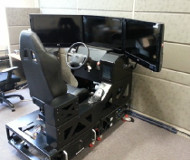Article from: www.thenewspaper.com/news/50/5006.asp
7/21/2016
Minnesota Study Finds No Benefit To Work Zone Speed Cams
Speed cameras failed to produce any significant results in a Minnesota DOT work zone study.
 Several states, including Maryland and Illinois, deploy speed cameras in highway "work zones" claiming that their use will reduce accidents. A Minnesota Department of Transportation (DOT) study released at the beginning of the year found no evidence that speed cameras had any positive impact on driver behavior and awareness.
Several states, including Maryland and Illinois, deploy speed cameras in highway "work zones" claiming that their use will reduce accidents. A Minnesota Department of Transportation (DOT) study released at the beginning of the year found no evidence that speed cameras had any positive impact on driver behavior and awareness.
Minnesota DOT officials have long been keen on implementing automated ticketing. Their study set out to investigate the relative effectiveness in a work zone of using no enforcement, a visible police car, and speed cameras with and without a dynamic "your speed is" sign. The study began with an opinion survey, not of the public, but of 29 assorted DOT employees and state police officials. Participants rated speed cameras dead last in expected impact on work zone safety and they agreed that driver distraction, not speeding, was the greatest threat.
"While distraction is not often cited as a leading contributing factor for all fatal crashes in Minnesota or in the United States, it is frequently indicated as a first or second contributing factor for all types of work zone crashes," the report noted.
Because Minnesota cannot legally use speed cameras on its highways, the study invited 90 participants to a University of Minnesota driving simulation lab that used eye-tracking glasses so that would know when the driver looked down at his speedometer and made a speed correction. The test was conducted on a simulated road where orange barrels and signs noted a speed limit reduction from 65 MPH to 55 MPH.
As an incentive, participants would be given a $10 gift card for completing the driving route in a specified time, but each time they received a speed camera ticket, they would lose $2. The results showed that motorists turned their eyes away from the road and fixated on their speedometer most when a simulated police car was visible on the road.
"Overall, the results do not strongly support the hypothesis that automated speed enforcement without a dynamic speed display sign improves driver attention in work zones," the study concluded. "Drivers do engage in more glances to their speedometer in the automated speed enforcement plus dynamic speed display sign work zones compared to automated speed enforcement only, but they do not appear to be overly occupied with this monitoring since they do not monitor their speedometer significantly more often compared to when police are present or under no enforcement conditions."
The study did not examine the effect of using the speed display signs on their own, without cameras. A copy of the study is available in a 3mb PDF file at the source link below.
Source: Examining the Impact of Automated Speed Enforcement in Work Zones on Driver Attention (Minnesota Department of Transportation, 2/1/2016)
Permanent Link for this item
Return to Front Page
 Several states, including Maryland and Illinois, deploy speed cameras in highway "work zones" claiming that their use will reduce accidents. A Minnesota Department of Transportation (DOT) study released at the beginning of the year found no evidence that speed cameras had any positive impact on driver behavior and awareness.
Several states, including Maryland and Illinois, deploy speed cameras in highway "work zones" claiming that their use will reduce accidents. A Minnesota Department of Transportation (DOT) study released at the beginning of the year found no evidence that speed cameras had any positive impact on driver behavior and awareness.